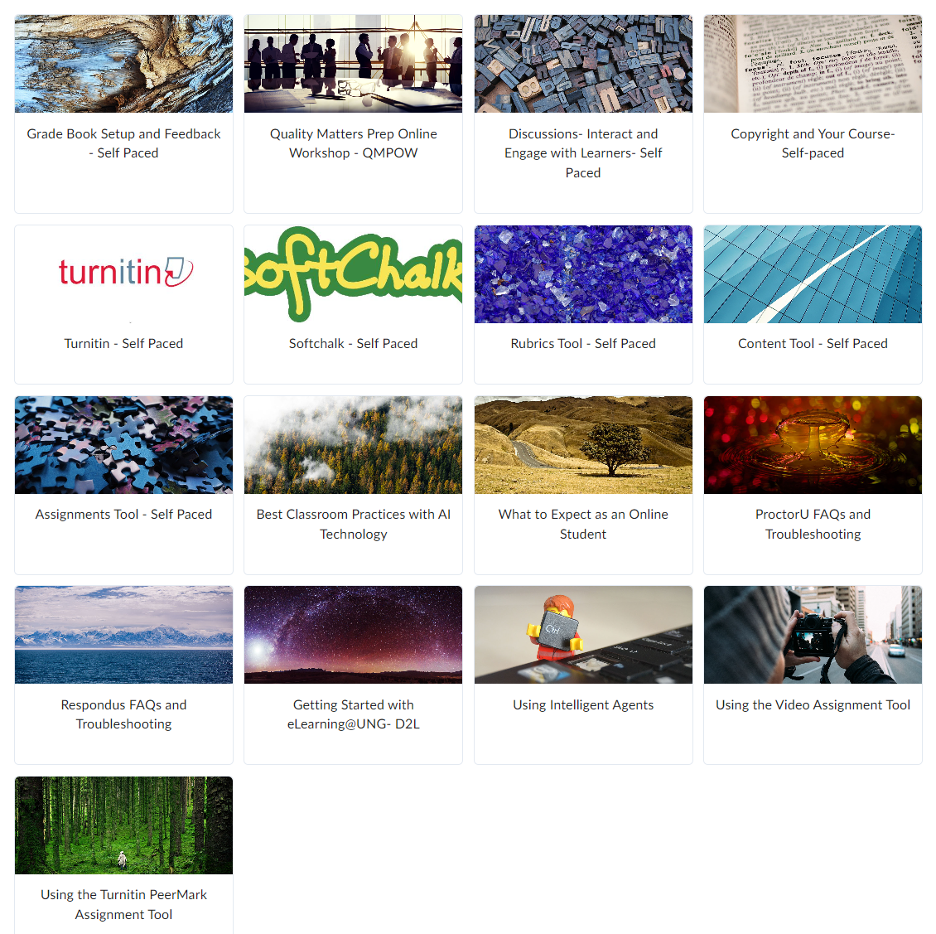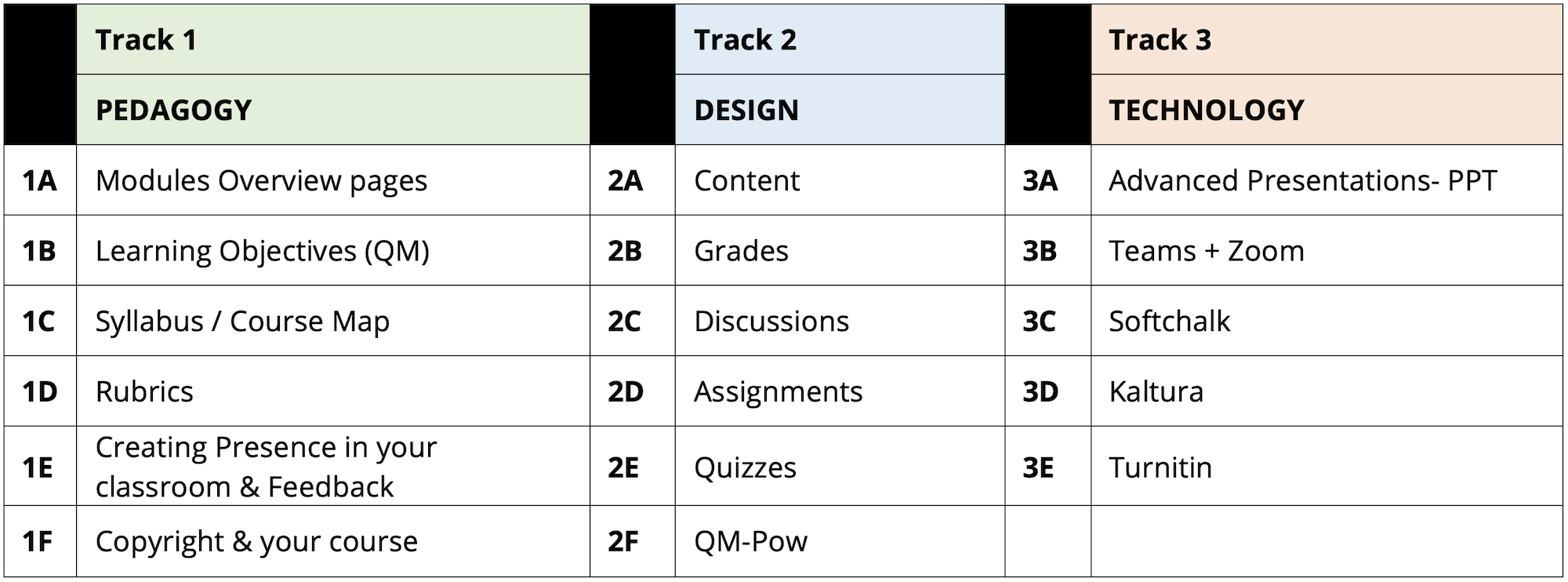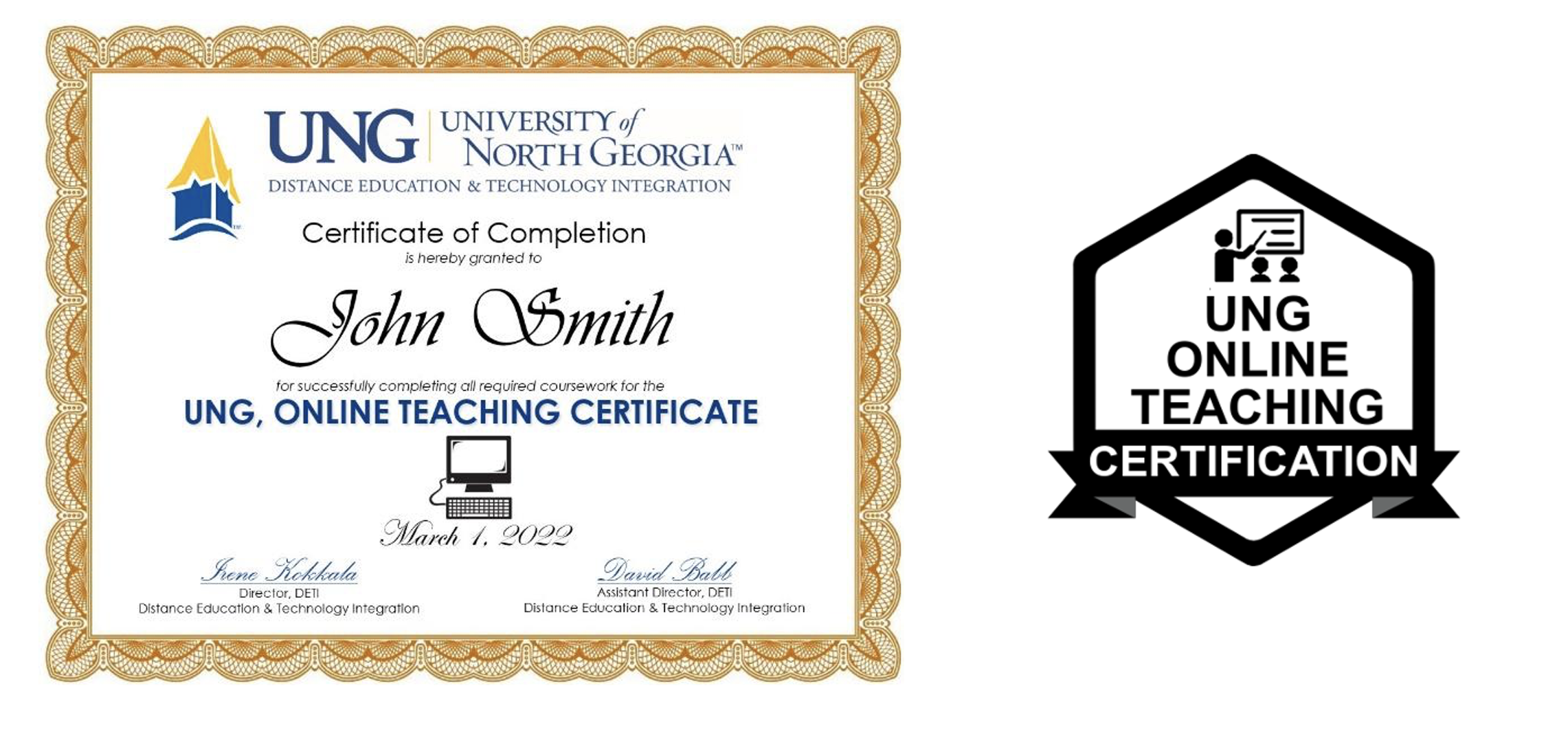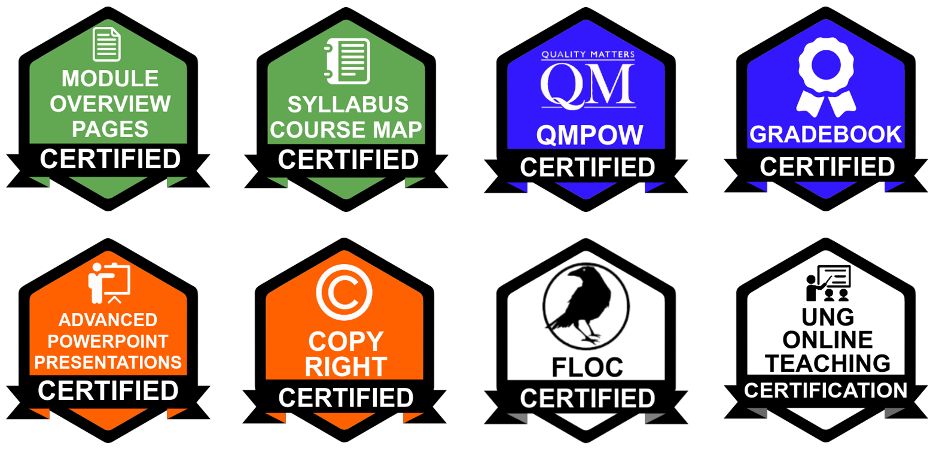Abstract
The University of North Georgia’s division of Distance Education & Technology Integration, DETI, developed a series of self-paced workshops to assist faculty in professional development as a response to faculty inquiries and the pandemic. The pandemic changed the way we look at our professional development opportunities. DETI concluded that we needed to re-visit our method of professional development opportunities. This presentation outlines the way we use our self-paced workshops to allow faculty to gain new knowledge and complete the workshops when it best fits into their schedules. It outlines UNG-DETI’s progress in designing and developing self-paced, course workshops and digital badge designs. Successfully completing a workshop earns a badge that culminates in our UNG Online Teaching Certification, UNGOTC. As a continuation in improving the quality of our micro-credentials and badging system and contribute to existing literature, we are conducting a pilot (mixed methods) study to understand the UNG faculty participants’ perceptions about our micro-credential series for continued improvement and quality.
Beginnings
Distance Education and Technology Integration, DETI develops and facilitates multiple workshops, as part of our commitment to faculty development. Before the pandemic, we saw a shift in faculty becoming more unresponsive to face-to-face workshops and our participation was at an all-time minimum. UNG has seen a dramatic decline in participation of our professional development opportunities, in both face-to-face and webinars. This decline comes from recognizing the challenges of our faculty, such as varying course workloads, scheduling conflicts, and other academic duties that prevent them from attending face-to-face workshops. The pandemic was a catalyst to developing fully online workshops. At first, we decided to transition to a more webinar focused workshop schedule. We did see a rise in the participants, for a time. Even that started to decline before the pandemic. DETI concluded that the we should revisit the method of professional development opportunities and developed a series of self-paced workshops that allow faculty to gain this new knowledge at their own pace. With the pandemic happening, like most universities, we transitioned to a fully online presence. DETI created a self-paced fully online workshop series to onboard new faculty and give existing new opportunities for profession development and saw a very positive response. We found our faculty are more responsive to taking a workshop they can complete at their own pace. To support this new paradigm shift of professional development, we have instituted a new badging system as well as a “menu” approach to the workshops required to achieve the UNG Online Teaching Certificate, UNGOTC. Each completed workshop grants the learner a digital badge that culminates in our UNG Online Teaching Certification. The menu (Figure 1) allows the instructor to choose from multiple workshops in different tracks. This gives our faculty the opportunity to be more invested in the certificate by choosing courses that apply to their own interests. DETI refocused the professional development menu to building all current offerings into self-paced workshops.
As a solution to meeting this dramatic decline, DETI refocused our professional development opportunities to building all our current offerings as well as future offerings into self-paced, online workshops. We have updated the existing online certification workshops, to award digital badges for successful completion of a workshop. The workshops are chosen from a three-tiered menu that culminates in the UNG online teaching certification. The Facilitating Learning Online Certificate, FLOC, will serve as precursor to a series of micro-credential courses in offering best practices of teaching online and instructional deliveries for faculty and professional development. This track process grants UNG faculty more autonomy in choosing specific online workshops by their own interests that culminates to their future UNGOTC.
Supporting rapid growth
The DETI division, of UNG, manages all online courses offered through the academic departments. We create new professional development opportunities and educate faculty in online design, management and LMS tool usage. Faculty choose from a menu of professional development opportunities and are a fully online experience, at the individual pace of the enrolled faculty. All self-paced workshops have an estimated time of completion to aid faculty in scheduling their time commitment. Opportunities are in each self-paced workshop to contact DETI for support. Each participant works at their own pace and typically completes the course within the posted time commitment.
Setting the stage: FLOC as our flagship workshop
Facilitating Learning Online Certification, FLOC, is the flagship of our newly designed professional development process. Per the UNG handbook, all online instructors must complete the FLOC workshop.
UNG's Faculty Handbook. 8.4.1
All faculty teaching fully online instructors will be certified either through prior experience or through the Distance Education & Technology Integration (DETI) certification process; this includes a self-paced course on teaching online.
The FLOC workshop is fully online and at the individual pace of the student. Facilitators are available through email, as required. It provides faculty with the necessary competencies to teach an online course for UNG and focuses on theory, concepts, and best practices for effective online facilitation including UNG specific content. It also prepares faculty in the skills related to the LMS (Learning Management System) and other software. FLOC serves as precursor to a series of future micro-credential courses in offering best practices of teaching online and instructional deliveries for faculty and professional development.
In Figure 1, FLOC is the only workshop faculty are required to attend. UNG online faculty are required to complete the Facilitating Learning Online Certification workshop before teaching online. All others are voluntary. In support of this policy, we developed the professional development menu to meet our professional development goals. However, it goes beyond this, as UNG acknowledges that continued professional development is paramount in providing high quality teaching to our students.
Figure 1. The header design of the FLOC online, self-paced workshop

FLOC introduces new seasoned instructors to trends in online teaching, best practices, UNG specific directions and required facilitation of an online class at UNG. It focuses on theory, concepts, and practices for effective online facilitation in addition to UNG specific information. This workshop takes faculty through the basics of how to set up their online course and directs them in how to use the LMS. FLOC is a living course. It is continuously updated with new best practices and suggestions from the end of course surveys. It is the stepping off point for additional, more focused workshops in a specific subject. Successful completion of FLOC is the first step to achieving the UNG Online Teaching Certification, UNGOTC.
Using D2L’s EXPLORE to access UNG’s self-paced professional development
DETI has chosen to use D2L’s Explore feature. Explore allows participants to review and self-enroll from list of workshops. (Figure 2)
Figure 2. The EXPLORE dashboard of self-paced, online workshops

Tracks: Steps to achieve the UNG Online Teaching Certificate, UNGOTC
1- Each semester new online/hybrid faculty are required to complete the FLOC workshop before teaching online with UNG.
2- Along with this, faculty have access to the professional development menu. (Table 1)
3- Faculty choose the 6 additional workshops they would like to attend. Selecting two self-paced workshops from each track.
4- Each successfully completed workshop earns the faculty member a digital badge.
5- After successfully completing FLOC + 6 workshops (7 total), faculty members are awarded our UNG online teaching certificate, UNGOTC and its digital badge. (Figure 3)
Table 1. Track system of professional development menu

Figure 3. Image of the UNG Online Teaching certificate (printed-paper) with its digital badge.

Micro-credentials at UNG
In figure 4, UNG chose to offer electronic badges to successfully completed workshops. Successful completion of 6 additional workshops, from the menu, culminate in a UNG Online Teaching Certificate, UNGOTC.
Figure 4. Examples of digital badge designs of the self-paced online workshops.

Current trends in digital badges
In recognition of these current trends, the researchers have updated the existing online certification workshop, FLOC, to award digital badges to our faculty for their completion of the FLOC workshop and the promotion of a series of workshops from a three-tiered menu that will culminate in a UNG online teaching certification.
Current trends indicate that digital badges are prominent in higher education and industry.
For example:
- Technology, healthcare and finance have become some of the most popular topics in digital badges for the past three years (www.emergingtech.com, as cited in UPCEA, 2020).
- Companies such as IBM, Salesforce, and Ernst & Young have developed their own badging initiatives. IBM alone doubled the number of badges issued in 2019 (www.emergingtech.com, as cited in UPCEA, 2020).
- Academic segment has been elevating as the primary market for digital badges. This is largely due to an increase in promoting credentials as a way for teachers and others to gain professional education in various topics (www.insidehighered.com, as cited in UPCEA, 2020).
Pandemic: Effects on professional development.
During the COVID-19 pandemic, students were asked to remain home while their courses and many of their research and internship undergo a reconfiguration to online platforms (Baker & Lutz, 2021). The sudden increase involving faculty members to shifting their teaching and learning methods to online platforms remains to overwhelm them and instructional technologists and staff as well (Baker & Lutz, 2021).
The COVID-19 pandemic crisis affected the traditional practice of education practices from its face-to-face setting to online learning. Basham et al (2020) identified the transition to online instruction as without any forewarning or training. Basham et al (2020) reported that 91.3% of global student population were out of school due to the pandemic and dramatically changed the face of the education system. However, the pandemic offered an expansion of digital technological tools for ensuring teleworking and distance learning. Bentata (2020) reported that the COVID 19 pandemic has imposed education completely by distance on millions of students and forced institutions and countries to invest in and fully adapt, making distance learning one of the great challenges of the COVID-19 pandemic.
Based on these two justifications (e.g., current trends and the COVID-19 pandemic) that lead to the culmination of the design and development of the UNGOTC for faculty and professional development.
The FLOC will serve as precursor to a series of future micro-credential courses in offering best practices of teaching online and instructional deliveries for faculty and professional development.
Originally, the use of open micro credentials to indicate educational progress was adapted from youth scouting programs (Zhang & West, 2020). Zhang and West support the use of open badges for micro credentials in creation and issue for validating an individual’s acquisition of a skill in training settings (Zhang & West, 2020).
In agreement with Cheng et al. (2018) and Zhang and West’s (2020) depictions, UNG-DETI encourages UNG faculty to successful complete the FLOC workshop as the first step in obtaining their UNG online teaching certification. In combination with FLOC and additional self-paced online courses, UNG faculty can choose and complete the required number of workshops and be awarded the UNG online teaching certification.
Purpose of the pilot study
The pilot study would identify any discrepancies affecting validity and reliability of the data collecting instruments administrated to the UNG faculty participants assessing their perceptions about micro-credentials and the digital badging system.
The researchers will report on the proposed pilot study with 14 UNG faculty participants using a participatory inquiry type as one of the qualitative rules of thumb by Mertens (2005) to also represent the quantitative sample size. As a step forward for implementing our proposed plan to conduct a pilot study, the researchers completed an UNG-IRB (institutional review board) online application and received an IRB approval letter in proceeding with the pilot study.
Rationale
As a continuation to improve the quality of our self-paced workshops (micro-credentials) and badging system and contribute to existing literature, the researchers propose a plan to conduct a pilot (mixed methods) study to understand the UNG faculty participants’ perceptions about our micro-credential series and the digital badging system for online teaching certification.
Research Design
Mixed Methods exploratory. The researchers proposed to use a mixed methods exploratory research design because it offers a combination of qualitative and quantitative methods that enables a researcher to apply a qualitative approach as an exploratory phase of the study and then follow up with the quantitative approach for a larger scale of the study (Chow et al., 2010, as cited in Howard, 2014).
Research Question 1. What are the UNG faculty participants’ perceptions about the micro-credential series and digital badging system for online teaching certification?
The central phenomenon for this qualitative research question is the UNG faculty participants’ perceptions about micro-credential series for online teaching certification. Using a directional hypothesis based on certainty of the expected outcome or predicted result of the variables involved the difference between UNG faculty receiving feedback and UNG faculty not receiving feedback (Falk et al., 2012; Ursu et al., 2003, as cited in Howard, 2014). An important aspect of instructional design of micro-credentials is a careful receipt of feedback both at the individual badge level and over the entire learning journey (as cited in Gish-Lieberman et al., 2021)
Null hypothesis 1: There is no difference between NASA TLX rating scores of the UNG faculty participants receiving feedback than the UNG faculty participants not receiving feedback.
(H0:µ1 = µ2)
Alternative hypothesis 2: There is a difference between NASA TLX rating scores of the UNG faculty participants receiving feedback than the UNG faculty participants not receiving feedback.
(H0:µ1 > µ2)
Qualitative Procedures
After obtaining permission to use data collection instruments and methods (e.g., survey questions, coding schema, and coding themes) from Besser and Newby (2019) and Dyjur and Lindstrom’s (2017) studies, the researchers created a survey instrument using the MachForm online form application in collecting qualitative and quantitative data from UNG faculty participants.
Open-ended questions. The researcher will collect qualitative data from the survey instrument and enter each data set in on an Excel spreadsheet. The researcher will codify the responses from the survey questions by matching to the following themes:
Learning for mastery (LM): The learner receiving responses about acquired learning ability, skills, meeting the course or module learning objectives, and asking about the critical course components (e.g., instructional materials, assessments, and learning activities) of micro-credentials.
Engagement involving motivation (EM): The learners experiencing positive motivation interaction at some level in terms of asking and responding to questions about micro-credential(s) and digital badging system.
Engagement involving performance (EP): The learners receiving engagement and interaction at some level in terms of asking and responding to questions about their performance towards completing the requirements of the micro-credentials and the digital badges.
Digital literacy (DL): The learner’s ability to communicate with social media platforms such as LinkedIn, Twitter, Facebook, or other social media platforms. The researcher will post hyperlink to the survey instrument in an email with directions on completing the survey instrument. The data collected is stored on the MachForm Server and researcher receives a copy of UNG faculty participants’ data responses via email notification.
Data analysis. The researcher will analyze and compare responses from emails of the selected UNG faculty participants and open-ended survey questions. “The researcher will interpret the significant statements with the aligned significant themes in explaining the phenomenon as the essence and meaning of the phenomenon” (Creswell, 2007, as cited by Howard, 2014, p.78).
Quantitative Procedures
Survey questions. On the survey instruments, there are ordinal questions (e.g., strongly agree, agree, not sure, strongly disagree, and agree) types that will collect data identifying significant (statistical) measures between UNG faculty receiving feedback (responses) and UNG faculty not receiving feedback (responses) in their perceptions about micro-credentials and the digital badging system. The same survey questions will appear with the open-ended questions on the survey instrument created by the MachForm online form application. The data collected is stored on the MachForm Server and researcher receives a copy of UNG faculty participants’ data responses via email notification.
NASA-TLX (Task Load Index). "The NASA TLX (Task Load Index) questionnaire is a multi-dimensional workload assessment tool utilized for measuring mental and physical workload required for completing a learning task" (Hart & Staveland,1988; Miller, 2011; Rubio et al., 2004, as cited by Howard, 2014, p.77). “The NASA TLX has a six dimension. The NASA TLX has six-dimensional rating items: mental demands, temporal demands, physical demand, performance, effort, and frustration in assessing cognitive aspects of the individual’s cognitive load in completing an entire task” (Currie, 2008; Rubio et al., 2004; Trujillo, 2011, as cited by Howard, 2014). Each dimensional rating scale has 21 vertical tick marks that divides the scale from 0 to 100 increments where each tick mark is measured as 5. The researchers reformatted the NASA TLX (PDF) file document as an editable PDF document. Now, the UNG faculty can mark their selections with a letter or character, “x” between the indicated tick marks for each dimensional rating area on the editable NASA-TLX document from their desktop computers. The researchers plan to email a copy of the NASA TLX in a PDF format to fourteen UNG faculty participants to complete and email it back to the researchers.
Data analysis. Apply Paired T-tests and correlational analyses on the NASA TLX index ratings.
Paired sample t-test. The researchers will apply a paired sample t-test in analyzing the NASA TLX ratings of both groups in addressing the research question and determine statistical differences.
Correctional test. The researchers will apply a correlational test in analyzing the NASA TLX ratings of both groups about levels of significant relationships and in addressing the research question. The researchers will apply the same approach in Gehbauer’s study, by designating the critical values and as benchmarks to determine how strong the indication of evidence between the independent variables (Gehbauer, 2010, as cited in Howard, 2014). Thus, the researchers will determine the strength of the participants’ perceptions about micro-credentials by comparing p-values from the NASA TLX cognitive index ratings with the critical values as benchmarks (Gehbauer, 2010, as cited in Howard, 2014). The p-values less than the critical value ( where represents a strong relationship (Gehbauer, 2010, as cited in Howard, 2014, p. 128). The p-values greater than the critical value and less than the critical value ( where represents a weak relationship (Gehbauer, 2010, as cited in Howard, 2014, p. 128). The p-values greater than the critical value ( where represents no relationship (Gehbauer, 2010, as cited in Howard, 2014, p. 128).
Proposed final study
Once the researchers have determined that the data collecting instruments are valid and reliable, the researchers will accept the proposed prior analysis that determined the appropriate and quantitative sample size of the final study and it aligns to supporting the qualitative sample size.
Quantitative sample size. Mertens (2005) recommended a statistical program in calculating an estimated sample size because the optimum sample size has a direct relation to the type of research where the appropriate sample size is necessary. Using a priori analysis provided an efficient method in controlling statistical power before the start of the actual study (Faul et al., 2007; as cited in Howard, 2014). The researchers generated a priori analysis showed the effect size for the intended study is, 0.50, alpha , and the actual statistical power is 0.9514318 where t (194) = 1.6527460. The sample size for the actual study will be calculated as 198 participants divided into two groups. The study expected to achieve the likelihood of a 95% probability that 198 participants was sufficient in finding a statistical relationship with the effect size of 0.50 between variables where (Faul et al., 2007; Melenovich, 2012; as cited in Howard, 2014).
Qualitative sample size. Using a participatory inquiry type as one of the qualitative rules of thumb by Mertens (2005) to determine a recommended sample size as a supportive approach to align with the calculated, quantitative sample size generated by the priori analysis.
Future considerations
The researchers could consider utilizing the self-regulated learning theory that could offer benefits to encourage learners to plan, set goals, monitor, and evaluate their learning processes (Zimmerman, 1990, as cited in Carey & Stefaniak, 2018; Krauel-Nix et al., 2019). The researchers would consider a plan to apply self-regulated learning techniques with instructional design when creating micro-credential programs for UNG students and UNG alumni.
Gish-Lieberman et al’s. (2021) study concluded that micro-credentials could continue to flourish in educational research in supporting formative development as the need for standards and best practices in instructional design becomes a priority.
Self-regulation. Newby and Cheng (2020) exclaimed that digital badges could influence self-regulated learning (SRL) development by providing a list of performance criteria in motivating the leaner to plan and establish goals in completing learning, comparing, and self-evaluate their performance level. By offering the UNG faculty, the opportunity to select or choose corresponding self-paced, course workshops from micro-credentials program that underlines the three micro-credential categories: PEDAGOGY, DESIGN, and TECHNOLOGY displays one of the aspects of the self-regulation learning theory. As the UNG faculty members must complete nine micro-credential courses from their selections, they can plan on how to select their learning of achieving and meet desired goals towards completing the UNG online teaching certification.
Acknowledgements
The researchers want to acknowledge and thank Besser and Newby for the permission and modification of their survey instrument and borrowed coding schema (Besser & Newby, 2019). In addition, the researchers want to acknowledge and thank Dyjur and Lindstrom for the permission and modification of their survey questions (Dyjur & Lindstrom, 2017).
References
Basham, J.D., Blackorby, J., & Marino, M.T. (2020). Opportunity in crisis: The role of universal design for learning in educational redesign. Learning Disabilities: A Contemporary Journal, 18, 71-91. Retrieved from Academic Search database.
Bentata, Y. (2020). COVID 2019 pandemic: a true digital revolution and birth of a new educational era, or an ephemeral phenomenon? Medical Education Online, 25, 1-2. https://doi.org/10.1080/108729
Besser, E.D., Newby, T. J. (2019). Exploring the role of feedback and its impact within a digital badge system from student perspectives. TechTrends: Linking Research & Practice to Improve Learning. 63(4), p485-495. doi: 10.1007/s11528-019-00386-2.
Carey, K.L. & Stefaniak, J.E. (2018). An exploration of the utility of digital badging in higher education settings. Educational Technology Research & Development, 66 (5), p1211-1229. doi: 10.1007/s11423-018-9602-1.
Cheng, Z., Watson, Lee, S., & Newby, T. J. (2018). Goal Setting and Open Digital Badges in Higher Education. TechTrends: Linking Research & Practice to Improve Learning, 62(2), 190-196. doi: 10.1007/s11528-018-0249-x.
Crisp, E.A. & Bonk, C.J. (2018). Defining the learner feedback experience. TechTrends, 62, 585-593. doi:10.1007/s11528-018-0264-y
Dyjur, P. & Lindstrom, G. (2017). Perceptions and Uses of Digital Badges for Professional Learning Development in Higher Education. TechTrends 61, 386–392 (2017). https://doi.org/10.1007/s11528...
Gish-Lieberman, J J.; Tawfik, A., & Gatewood, J. (2021). Micro-credentials and badges in Education: A historical overview. TechTrends: Linking Research & Practice to Improve Learning. 65(1), 5-7. doi: 10.1007/s11528-020-00567-4.
Howard, E. (2014). Understanding undergraduate students’ perceptions of using cognitive load strategies in solving exponential expressions (UMI 3621588). [Doctoral dissertation, Capella University].
Krauel-Nix, M., Evans, N.W., Eckstein, G., & McMurry, B.L. (2019). Designing and developing an online self-regulated learning course. International Journal of Designs for Learning, 10 (1), 103-115. Retrieved from ERIC database (EJI1258963).
Mertens, D.M. (2005). Research and evaluation in education and psychology: Integrating diversity with quantitative, qualitative, and mixed methods (2nd ed). Thousand Oaks, CA: Sage.
Newby, T.J.& Cheng, Z (2020). Instructional digital badges: effective learning tools. Educational Technology Research & Development, 68(3), 1053-1067. doi: 10.1007/s11423-019-09719-7.
UPCEA: Center for Research & Strategy (2020). An update on micro-credentials and digital badges.
Virkus, S. (2019). The use of open badges in library and information science education in Estonia. Education for Information, 35, 155-172. doi: 10.3233/EFI-190257.
Zhang, J. & West, R.E. (2020). Designing micro-learning instruction for professional development through a competency based approach. TechTrends: Linking Research & Practice to Improve Learning, 64, 310-318. https://doi.org/10.1007/s11528.

